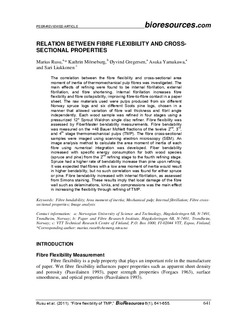Relation between fibre flexibility and cross-sectional properties
Journal article, Peer reviewed
Published version

View/
Date
2011Metadata
Show full item recordCollections
Original version
BioResources. 2011, 6 (1), 641-655.Abstract
The correlation between the fibre flexibility and cross-sectional area moment of inertia of thermomechanical pulp fibres was investigated. The main effects of refining were found to be internal fibrillation, external fibrillation, and fibre shortening. Internal fibrillation increases fibre flexibility and fibre collapsibility, improving fibre-to-fibre contact in a paper sheet. The raw materials used were pulps produced from six different Norway spruce logs and six different Scots pine logs, chosen in a manner that allowed variation of fibre wall thickness and fibril angle independently. Each wood sample was refined in four stages using a pressurized 12" Sprout Waldron single disc refiner. Fibre flexibility was assessed by FiberMaster bendability measurements. Fibre bendability was measured on the +48 Bauer McNett fractions of the twelve 2nd, 3rd, and 4th stage thermomechanical pulps (TMP). The fibre cross-sectional samples were imaged using scanning electron microscopy (SEM). An image analysis method to calculate the area moment of inertia of each fibre using numerical integration was developed. Fiber bendability increased with specific energy consumption for both wood species (spruce and pine) from the 2nd refining stage to the fourth refining stage. Spruce had a higher rate of bendability increase than pine upon refining. It was expected that fibres with a low area moment of inertia would result in higher bendability, but no such correlation was found for either spruce or pine. Fibre bendability increased with internal fibrillation, as assessed from Simons staining. These results imply that local damage of the fibre wall such as delaminations, kinks, and compressions was the main effect in increasing the flexibility through refining of TMP.